Mastering the Art of Bleaching Clothes in a Washer
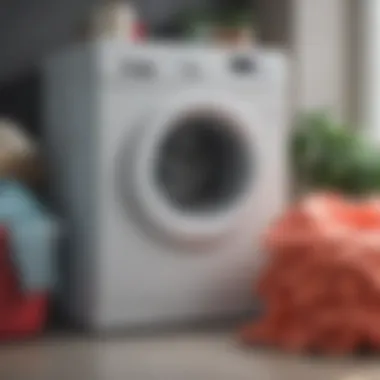
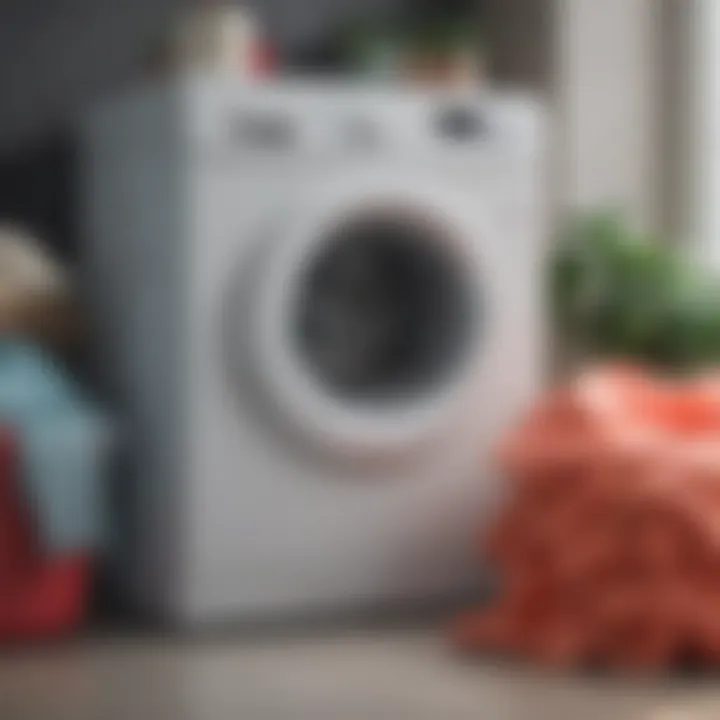
Intro
Bleaching clothes in a washing machine may seem straightforward, but it requires a thorough understanding of the methods and materials involved to ensure success. Many individuals seek to lighten or remove stains from clothing, making bleaching a common household practice. However, achieving optimal results involves careful selection of bleach type, attention to fabric care, and consideration of safety protocols. This article will provide a detailed exploration of effective techniques, maintenance practices, and safety guidelines for utilizing bleach in a washing machine setup.
Design Inspiration
While the primary purpose of bleaching clothes often revolves around utility, the aesthetic outcomes can significantly enhance a wardrobe. Adopting a well-thought-out approach in this process may lead to vibrant, refreshed garments that reflect modern trends.
Trending Styles
Bleached fabrics can fall into several categories of style, including vintage and artistic aesthetics. Many homeowners and interior design enthusiasts have gravitated towards distressed or tie-dye effects, achieved through creative bleaching techniques. These styles often showcase variety, providing visually appealing options for various occasions. The incorporation of such styles can largely influence the overall design of a living space, as textiles and garments often play a key role in designing a coherent visual identity.
Color Palettes
Bleached fabrics shine brightly within specific color palettes. Soft pastels or clean whites can offer a serene and spacious feel in clothing or home textiles. Some might prefer bolder options, integrating vibrant shades alongside bleached areas for a striking contrast. Testing color combinations can yield interesting results, while also ensuring that the final product remains stylish. When selecting colors, consider how they will harmonize with existing pieces to create cohesion.
Practical Tips
Implementing effective bleaching techniques also requires practical insights.
Maintenance & Care
To maintain the brilliance of bleached garments, it is essential to follow guidelines that promote longevity. This includes:
- Washing at low temperatures to prevent fabric damage.
- Avoiding overloading the washing machine, which can lead to uneven bleaching.
- Regularly cleaning the machine to remove residual bleach that might impact other washes.
Taking care of bleached fabrics properly can ensure they last longer while retaining their appeal.
Budgeting & Planning
Bleaching clothes can significantly reduce wardrobe costs, but some planning is required. Consider these points:
- Assess what clothes need bleaching before buying bleach products.
- Determine bulk purchases of bleach to save money on smaller quantities.
- Set aside time to complete the bleaching process, as proper application will yield better outcomes.
By prioritizing these aspects, you create an effective budget and plan, lending to a more organized approach to garment care and aesthetics.
Remember: Proper bleaching techniques lead to better results, enhancing not just the clothes but the space in which they are featured.
Prelude to Bleaching Clothes
Bleaching clothes is an essential process in laundry that can revive, clean, or enhance fabric appearance. Many homeowners underestimate the power of bleach as a cleaning agent, viewing it as something only for stubborn stains or white clothes. However, its correct use can lead to a noticeable difference in the overall look of garments. In this section, we will explore the basic concepts surrounding bleaching and its significance in effective laundry practices.
Understanding how bleach interacts with different fabrics, and the outcomes it can achieve, is key to making an informed decision about its use. Different types of bleaching agents offer various benefits that can clean and brighten clothes, making them an indispensable part of the laundry routine.
Understanding Bleaching Agents
Bleaching agents serve as powerful tools in the fight against stains, discoloration, and even odors in fabrics. Chlorine bleach, a commonly used agent, is highly effective but can be harsh on certain materials. It works by breaking down color molecules in fabrics, which leads to a lighter appearance. On the other hand, non-chlorine bleach, often made with oxygen-based compounds, offers a gentler alternative. This type of bleach can brighten clothes while being safer for delicate fabrics.
Factors like the desired result and fabric type need to be considered when selecting a bleach. Color-safe bleach is particularly useful for dyed fabrics, as it helps retain colors while still achieving a brightened look. Understanding these different agents can help homeowners make choices that prioritize both cleanliness and fabric integrity.
The Role of Bleaching in Laundry
Bleaching plays a significant role in keeping laundry fresh and vibrant. It not only addresses stains but can also minimize the dulling that occurs over time due to various factors like detergent residue or dirt buildup. Regular use of bleach, when needed, can maintain the original luster of clothing, especially whites, which tend to show age more quickly.

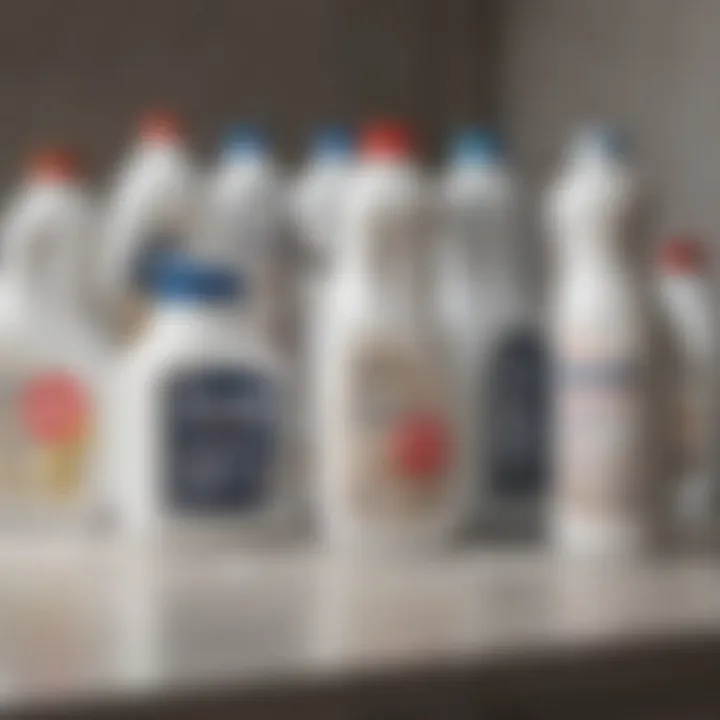
The act of bleaching can also enhance the perceived cleanliness of garments. When clothes appear bright, it contributes positively to the overall aesthetic and reflects an image of care and attention to detail. This aspect can be particularly important for homeowners who frequently host gatherings or wish to maintain a polished appearance in their attire.
"Understanding the role of bleach in laundry goes beyond aesthetic considerations; it’s about preserving fabric lifespans and ensuring your garments look their best."
Selecting the Right Bleach
Selecting the right bleach is a crucial step in the process of effectively brightening and cleaning clothes in a washing machine. Different bleach types serve unique purposes and have various effects on fabrics. Understanding these distinctions is essential for achieving the desired results while preserving the integrity of the garments. The choice of bleach can impact not only the cleanliness of the clothes but also their longevity, making informed selection vital for homeowners and those responsible for laundry.
Types of Bleach Available
Chlorine Bleach
Chlorine bleach is one of the most potent bleaching agents available. Its primary active ingredient is sodium hypochlorite, which works effectively to whiten and disinfect fabrics. This type of bleach is often favored for whites, as it is capable of removing even the toughest stains, such as grease and wine. However, it is important to note that chlorine bleach can weaken fibers over time, especially with repeated use. Furthermore, its harshness means it is not suitable for colored fabrics, as it can cause fading or discoloration. This makes it a beneficial option for whites, though caution should be exercised to avoid damage.
Non-Chlorine Bleach
Non-chlorine bleach is often seen as a milder alternative to chlorine bleach. It includes oxygen bleach, mainly sodium percarbonate, which releases hydrogen peroxide when mixed with water. Its gentler nature makes it safe for a wider range of fabrics, including colors. Non-chlorine bleach effectively cleans and brightens without the harsh effects that chlorine bleach can cause. However, it may not be as effective on tough stains when compared to its chlorine counterpart. Non-chlorine bleach is very useful in general cleaning tasks where both efficacy and fabric care are important.
Color-Safe Bleach
Color-safe bleach is specifically designed for use on colored fabrics. It typically contains non-chlorine agents that brighten colors without stripping them of their vibrance. The key characteristic of color-safe bleach is its ability to remove stains while keeping colors intact, making it a popular choice for everyday laundry. Its unique feature is its compatibility with most fabrics, allowing for versatility in usage. However, while color-safe bleach is effective, it may not match the stain removal power of chlorine bleach in certain situations. Knowing when to choose this option can provide a balance between cleaning and fabric care.
Considerations for Fabric Types
Cotton
Cotton is a widely used fabric in clothing and household textiles. Its ability to withstand higher temperatures makes it compatible with both chlorine and non-chlorine bleach. Cotton fabrics generally respond well to bleaching, resulting in a bright and clean appearance. The unique feature of cotton is its natural breathability, which contributes to comfort. However, excessive bleaching can lead to wear and tear over time, reducing the lifespan of cotton garments. Proper care in the bleaching process ensures that the cotton remains intact and maintains its quality.
Polyester
Polyester is a synthetic fiber known for its durability and resistance to wrinkles. When it comes to bleaching, polyester is more sensitive than cotton. Most standard bleaches can cause fading or damage the fabric. Therefore, non-chlorine and color-safe bleaches are best suited for polyester items. The key advantage of polyester is that it often retains its color well, but if bleach is misused, the results can be irreversible. Knowing how to treat polyester properly can prolong its life while still achieving noticeable cleaning results.
Delicate Fabrics
Delicate fabrics, such as silk or lace, require special consideration when bleaching. These materials are often more sensitive to harsh chemicals and temperatures. Bleaching delicate fabrics is typically not recommended due to the risk of damage. If gentle cleaning is necessary, just a diluted solution of non-chlorine bleach may be employed with extreme care. The key characteristic of delicate fabrics is their texture and appearance, which can easily be compromised. To preserve their beauty, it is advisable to limit bleaching and seek alternative cleaning methods instead.
In summary, selecting the right bleach involves careful consideration of the fabric type and desired results. Each bleach type has unique properties and effects that are essential to understand for successful laundry practices.
Preparing Clothes for Bleaching
Bleaching is not just about adding bleach to your laundry and hoping for the best. Preparing clothes for bleaching is a critical step in ensuring effective results and maintaining the integrity of your garments. Careful preparation can prevent fabric damage, enhance the effectiveness of the bleach, and help achieve the desired brightness of the clothes.
When done correctly, proper preparation will also minimize the risk of damaging colors on blended fabrics or causing unwanted fading. Thus, understanding this step can significantly impact both the appearance and longevity of your clothing.
Sorting and Inspecting Garments
The first step in preparing your clothes for bleaching is sorting them. Separating garments based on their fabric type and color is fundamental.
- White fabrics can generally withstand bleach more than colored ones due to their composition.
- Colored garments should be assessed for their dye stability. Some dyes are sensitive to bleach and may result in discoloration.
- Fabric types also matter. Cotton is usually safe for bleaching, while blends containing polyester may not react well.
While sorting, inspect your clothes for any stains or prior damage. Look closely at the seams, hems, and any areas that may appear worn. Stains that are not treated properly may not lift during the bleaching process. If the fabric is too damaged, bleaching could exacerbate the problem and further compromise the garment’s structure.
It can be beneficial to check for care labels as they often provide specific instructions regarding bleaching or the use of harsh chemicals. Following the manufacturer's recommendations can prolong the life of your clothing.
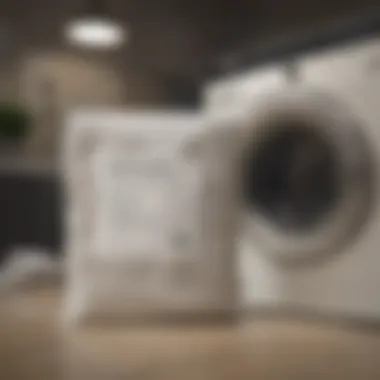
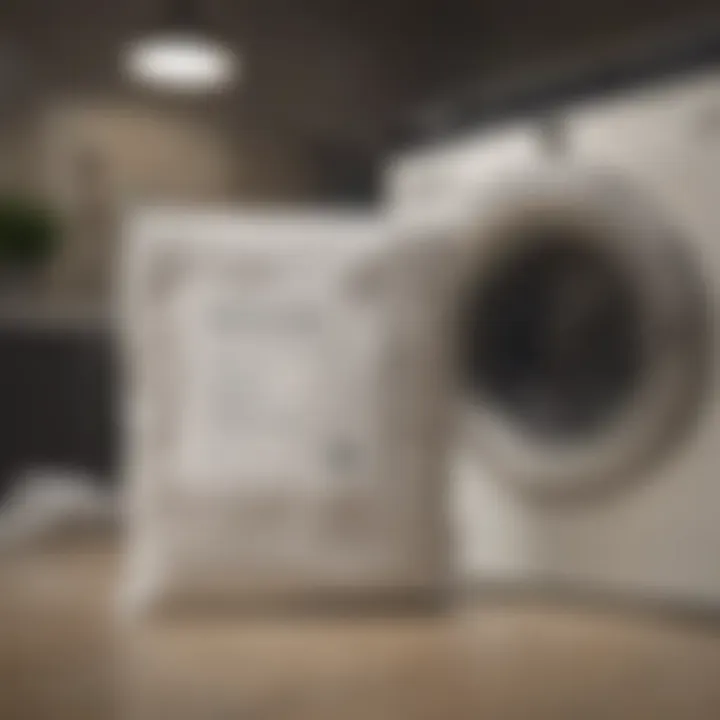
Pre-treating Stains
Once garments are sorted and inspected, the next step involves pre-treating any stains before bleaching. This step can significantly improve the overall outcome of the bleaching process.
- Start by applying a stain remover directly to the stain. Products like OxiClean MaxForce or Zout can be effective depending on the type of stain.
- Allow the stain remover to sit for at least 5 to 10 minutes before proceeding. This time helps to break down the stain and makes it more likely to be eliminated during washing.
- For persistent stains, gently agitate the fabric to help the product penetrate the fibers.
Once pre-treatment is complete, the garments can then be placed in the washing machine as per the steps outlined in the subsequent sections of the article. Addressing stains at the start is key to ensuring that your garments come out cleaner and brighter post-bleaching.
Bleaching Process in the Washing Machine
The bleaching process in the washing machine is essential for those seeking to revitalize or clean their fabrics effectively. This method allows for a systematic approach to bleaching, ensuring consistency and safety while achieving desired results. Understanding the steps involved can help individuals avoid common pitfalls. Moreover, adherence to proper techniques can yield brighter, cleaner garments without compromising their integrity.
Loading the Washing Machine
Loading the washing machine properly is a vital step in effectively bleaching clothes. It is crucial to balance the load; overloading can cause the bleach to distribute unevenly. This can lead to patchy bleaching results or even damage to garments. To correctly load the machine, place garments loosely to allow enough space for movement. This enables the bleach to permeate the fabrics evenly. Additionally, ensure that you separate bleachable materials from non-bleach fabrics to avoid unwanted discoloration.
Measuring Bleach Correctly
Correct measurement of bleach is essential for effective results. Using too much bleach can damage fabrics while using too little may not yield the desired effect. Generally, it is recommended to use a cup of bleach for a regular load in a standard washing machine. Always refer to the manufacturer's instructions on the bleach product for specific guidelines. Measuring carefully ensures that the strength of the bleach is adequate but not excessive, protecting garment quality and colors.
Choosing the Right Cycle Settings
The right cycle settings play a significant role in the bleaching process. This includes selecting appropriate water temperature and washing cycle duration.
Water Temperature
Water temperature directly impacts the effectiveness of bleach. Hot water can enhance the bleaching process, as warmth helps open up the fabric fibers, allowing bleach to penetrate effectively. Generally, a warm to hot water cycle is the most effective choice for bleaching whites or light colors. It is important to note that not all fabrics tolerate high temperatures. Thus, checking the care labels on garments is essential to avoid damaging delicate materials. A warm wash can also aid in the removal of stubborn stains. However, care must be taken not to exceed safe temperature limits to safeguard fabric integrity.
Washing Cycle Duration
Washing cycle duration is another critical factor in the bleaching process. A longer cycle allows the bleach more time to act on stains and discoloration, promoting better whitening. However, excessive cycle times can lead to fabric wear and tear. A typical washing cycle for bleaching should last around 10 to 15 minutes. Testing different durations might be necessary to determine the best option for specific fabrics. The washing duration should always consider the type of fabric in question, ensuring suitable care for delicate items while still achieving effective bleaching results.
Proper execution of these steps in the bleaching process can lead to satisfactory outcomes. Consistent consideration of these elements tallies into a successful laundry experience.
Post-Bleaching Care
Post-bleaching care is a crucial phase in the laundry process. Proper care after bleaching ensures the longevity of the fabric while enhancing the overall appearance of your clothes. After the initial bleaching process, it’s essential to take a few steps to maintain the integrity of the fabric and achieve desired results.
Rinsing and Drying Clothes
Rinsing is often underestimated but serves a vital purpose. After the bleach cycle, it is crucial to rinse garments thoroughly to remove any residual bleach. Residual bleach can lead to fabric damage or unusual discoloration, which defeats the entire purpose of the bleaching process.
To begin, run a rinse cycle in the washing machine. This may take one or two additional cycles depending on the amount of bleach used and the size of the load. Use cold water for rinsing, as it helps to close the fabric fibers and prevents additional fading.
Once thoroughly rinsed, the drying step becomes equally important. Dry your clothes carefully. Avoid direct sunlight, as it can cause further fading. Consider using a tumble dryer on a low heat setting or line drying in a shaded area. Remember to check care labels, as some fabrics may have specific drying instructions.
Assessing the Results
After rinsing and drying, it is time to assess the results. Examining your garments allows you to determine the effectiveness of the bleaching process and identify if further treatment is needed. Look for areas where the stain might have persisted or if the desired whiteness was achieved.
- Evaluate Color Uniformity: Check if the fabric is evenly bleached. Any uneven spots might require additional treatment.
- Inspect for Damage: Look for any signs of fabric weakness or holes. If the fabric feels brittle, avoid subjecting it to further bleach treatments.
- Feel the Texture: The fabric should not feel overly stiff or rough. If it does, this might be an indication of over-bleaching.
If the results are not satisfactory, you may need to consider re-treating the garment or switching to a gentler bleach option. Keep an eye out for any potential issues, as catching them early could save your favorite fabrics from permanent damage.
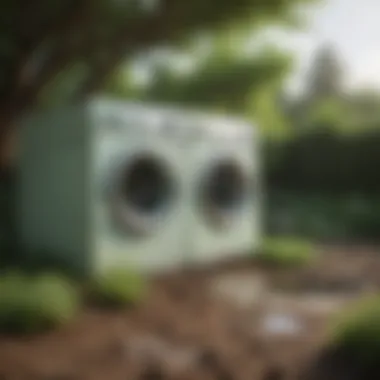
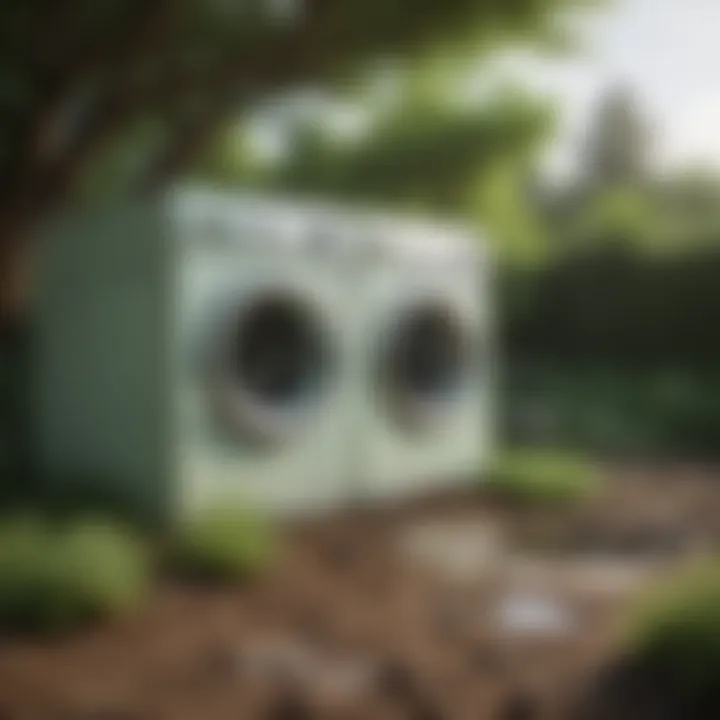
"Proper post-bleaching care not only enhances appearance but extends the lifetime of garments."
This thorough post-bleaching care routine will help you maintain brighter clothes while ensuring that your fabric remains intact and continues to serve its purpose.
Safety Considerations
Bleaching clothes brings brightness and freshness to fabrics, but it also poses certain risks. Understanding these hazards is crucial for a safe and effective laundry experience. Safety considerations not only protect your health but also ensure the integrity of your garments. Utilising bleach incorrectly can lead to damage, both to fabric and health. Thus, it is imperative to follow safety precautions when handling bleach.
Protective Measures to Follow
Gloves and Masks
Using gloves and masks is essential when bleaching clothes. Gloves protect your hands from harsh chemicals. They act as a barrier that prevents skin irritation. Many people overlook this simple step, leading to discomfort after contact with bleach. Masks help reduce inhalation of bleach fumes during the process. This helps to avoid respiratory issues, especially if you are working in a closed space. Overall, gloves and masks are beneficial choices for maintaining your health while working with bleach. Without them, you expose yourself to potential irritation and damage that can be easily avoided.
Ventilation
Ventilation is another critical aspect to consider. Proper airflow minimizes fumes that bleach releases. This can significantly decrease the risk of headaches or nausea. A well-ventilated area makes the bleaching process safer and more pleasant to perform. For example, you could open windows or use exhaust fans. The unique feature of ventilation is its ability to disperse toxic fumes efficiently. However, if the area is not ventilated, it could lead to an unsafe environment. Thus, ensuring good ventilation while bleaching is very important to maintain a safe space.
Understanding Risks of Improper Use
Improper use of bleach can lead to a variety of issues. On one hand, it can damage fabrics, making them weaken or discolor unintentionally. On the other hand, the health risks can be substantial. Skin contact may result in burns, while inhaling bleach can cause respiratory distress. Moreover, mixing bleach with other cleaning products can create hazardous gases. Therefore, it is vital to follow the recommended guidelines for bleach use. Being aware of these risks enhances the effectiveness of the process while prioritizing safety.
Environmental Impact of Bleaching
Understanding the environmental impact of bleaching is crucial for any conscientious homeowner. Bleaching agents can contribute to pollution and other negative effects on ecosystems. This section will dive into specific elements regarding chemical concerns and the alternatives that could lessen these impacts.
Chemical Concerns
Chlorine bleach, commonly used in households, contains sodium hypochlorite. This compound, while effective at whitening, can lead to harmful byproducts when released into the environment. When used excessively or improperly, chlorine bleach can mix with organic materials and produce dioxins and other toxic chemicals. Such compounds are known for their persistent nature and can bioaccumulate in the food web.
Furthermore, the manufacturing process of bleach also raises environmental concerns. The production involves significant energy consumption and the release of pollutants. Wastewater from bleaching processes can introduce harmful substances into rivers and oceans, affecting the wildlife of those ecosystems.
It is essential to consider both the direct and indirect environmental implications of bleach usage. Although it effectively removes stains and whitens fabrics, consumers must remain aware of the broader impacts on their surroundings. Choosing products with reduced chemical footprints can mitigate these risks.
Eco-Friendly Alternatives
Fortunately, there are viable alternatives to traditional bleaching agents that are less harmful to the environment. Options like hydrogen peroxide and sodium percarbonate have gained popularity among environmentally conscious consumers. These substances are more biodegradable and generally produce fewer harmful byproducts.
When selecting eco-friendly bleaches, look for labels that indicate non-toxic and biodegradable properties. Some brands make specific formulations that prioritize both cleaning efficacy and a reduced environmental impact. Here are a few options:
- Hydrogen Peroxide: A natural disinfectant that also whitens clothes. It breaks down into water and oxygen, presenting a low ecological risk.
- Sodium Percarbonate: A compound that releases hydrogen peroxide when mixed with water. It is effective at removing stains and is considered environmentally safe.
- Oxygen-based Bleaches: These bleaches rely on a process that breaks down stains using oxygen molecules instead of harsher chemicals.
By consciously opting for eco-friendly products, households can significantly reduce their environmental footprint. Moreover, many of these alternatives are effective in maintaining garment integrity, reducing the risk of fabric damage.
"Choosing eco-friendly alternatives not only protects the environment but also ensures the long-term health of your fabrics."
Finale
The conclusion of this article underscores the importance of effectively bleaching clothes using a washing machine. Bleaching has transformative potential for maintaining the brightness and cleanliness of garments, offering both aesthetic and hygiene benefits. By mastering the techniques outlined, readers can enhance the longevity of their fabrics while ensuring colors remain vibrant. Moreover, understanding the nuances of different bleach types and their effects on various textiles is crucial for preventing damage to beloved clothing items.
Further, embracing safety protocols not only protects personal health but also minimizes environmental impacts associated with chemical use. The balance between effective cleaning and ecological responsibility is a vital consideration for the modern homeowner. Thus, effective bleaching practices are not merely about achieving desired results, but also about safeguarding our fabrics and the environment alike.
Recap of Key Points
- Understanding Bleaching Agents: Recognizing the role of bleaching agents is fundamental—these chemicals can vary greatly in their application and effectiveness.
- Fabric Considerations: Different materials require different approaches; cotton, polyester, and delicate fabrics all respond uniquely to bleach.
- Preparation Steps: Properly sorting garments and treating stains before bleaching is essential for optimal results.
- Washing Machine Settings: Choosing the correct machine settings helps achieve an even distribution of bleach and prevents damage to the fabric.
- Post-Care Measures: Rinsing and drying correctly ensures that residual bleach is eliminated and prevents fabric deterioration.
- Safety Practices: Using gloves and ensuring proper ventilation are critical steps in using bleach safely.
- Environmental Considerations: Awareness of chemical concerns and eco-friendly alternatives helps align effective laundry practices with environmental responsibility.
Final Thoughts on Effective Bleaching
In summary, creating a routine that incorporates effective bleaching practices is a beneficial safeguard for one's wardrobe. By updating approaches to laundry and engaging with the knowledge shared in this article, readers can develop an informed strategy that promotes both efficacy and fabric care. This is not just about making clothes look better; it is about instilling a holistic understanding of garment care that extends the life of clothing and reduces waste. The insights shared here provide homeowners, designers, and enthusiasts with the tools to approach laundry with confidence and precision.















